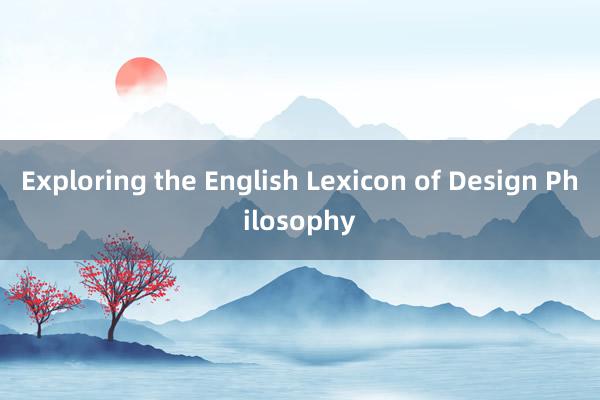时间:2024-09-24 10:18

### Exploring the English Lexicon of Design Philosophy
Design philosophy, as an interdisciplinary field, intertwines aesthetics, functionality, and cultural significance to create meaningful objects, systems, and experiences. The English lexicon plays a crucial role in shaping this discourse, offering a rich vocabulary that allows designers to articulate their ideas with precision and depth. This article delves into the English language's contribution to design philosophy, exploring how specific terms and concepts help us understand the essence of design.
#### 1. **Aesthetics (Aesthetic)**
At the heart of design philosophy lies the concept of aesthetics, which concerns the sensory qualities of an object or experience. In English, the term "aesthetic" not only describes the beauty or appeal of something but also encompasses the principles of composition and arrangement. It encourages designers to consider not just the visual aspects but also the emotional and sensory impact on the user.
#### 2. **Functionality (Functionalism)**
Contrasting with aesthetics is functionality, 宁夏蓝海大宗商品交易中心 which focuses on the practical use and utility of design. Functionalism, 首页-新昌宝颜料有限公司 a philosophical stance within design,锦泰中文小说网 - 网络小说排行榜 emphasizes that form should follow function. This principle is crucial for creating designs that are not only visually appealing but also serve their intended purpose effectively. Terms like "user-centered design" and "human-computer interaction" reflect this emphasis on functionality, aiming to enhance user experience through thoughtful design solutions.
#### 3. **Sustainability (Green Design,厦门市斯巴特进出口有限公司 Eco-Design)**
In recent years, sustainability has become a pivotal aspect of design philosophy, particularly in response to environmental challenges. Terms such as "green design" and "eco-design" highlight the importance of creating products and systems that are environmentally friendly. These concepts encourage designers to consider the lifecycle of a product, from its creation to disposal, aiming to minimize ecological impact while maximizing efficiency and resource conservation.
#### 4. **Cultural Significance (Cultural Appropriation vs. Cultural Adaptation)**
河北沃尔美塑胶制品有限公司Design philosophy also grapples with the cultural context in which it operates. Concepts like "cultural appropriation" versus "cultural adaptation" are crucial in understanding how design can respectfully incorporate elements from diverse cultures without perpetuating stereotypes or disrespecting traditions. This dialogue within the English lexicon helps designers navigate the ethical considerations of cultural representation and influence in their work.
#### 5. **Innovation (Innovative Design, Disruptive Innovation)**
Innovation is a driving force in design philosophy, pushing boundaries and challenging existing norms. Terms such as "innovative design" and "disruptive innovation" encapsulate the spirit of creating new solutions that can transform industries or solve long-standing problems. This focus on innovation encourages designers to think beyond conventional constraints, fostering creativity and forward-thinking approaches in their work.
#### Conclusion
The English lexicon provides a robust framework for design philosophy, enabling designers to articulate complex ideas with clarity and precision. From aesthetics to sustainability, the vocabulary of design philosophy reflects the multifaceted nature of this discipline, highlighting the importance of considering both form and function, cultural context, and ethical implications in every design decision. As design continues to evolve厦门市斯巴特进出口有限公司, the English language will undoubtedly adapt and expand, offering new terminologies to address emerging trends and challenges in the field.